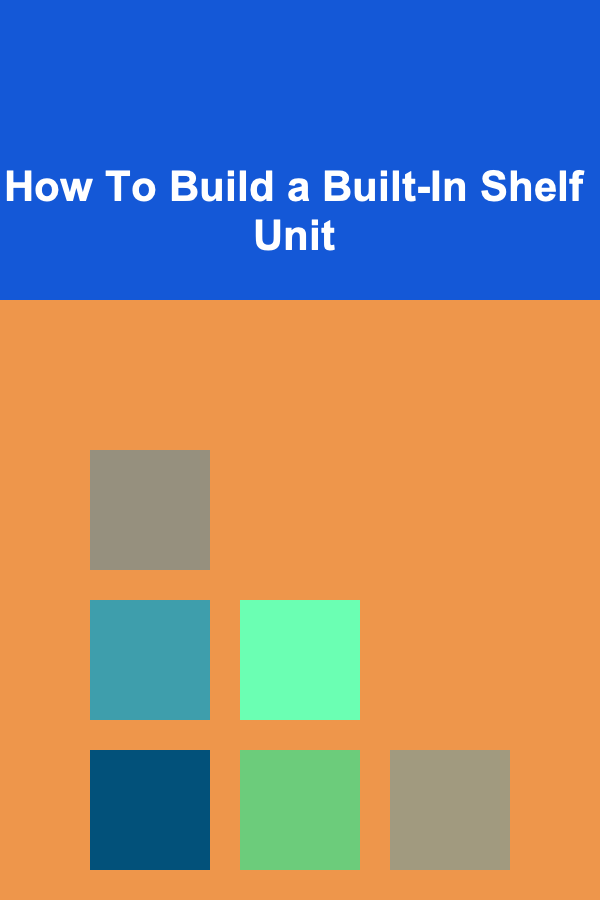
How To Build a Built-In Shelf Unit
ebook include PDF & Audio bundle (Micro Guide)
$12.99$11.99
Limited Time Offer! Order within the next:

Building a built-in shelf unit is an excellent way to maximize storage and enhance the aesthetic of your living space. Whether you're looking to add some stylish storage to your living room, bedroom, or office, a well-designed built-in shelf unit can serve both functional and decorative purposes. In this guide, we will cover the process of building a built-in shelf unit from start to finish, providing detailed steps, tips, and materials to help you complete your project successfully.
Why Choose a Built-In Shelf Unit?
Before diving into the construction process, it's important to understand why a built-in shelf unit is an excellent choice for your home. Here are some reasons why built-in shelves are an appealing option:
- Space Efficiency: Built-in shelves utilize wall space effectively, which is especially beneficial for smaller rooms or spaces where floor space is limited.
- Customizable Design: Built-in shelves can be designed to fit any space, allowing you to customize their size, shape, and finish to suit your needs and style.
- Aesthetic Appeal: Built-in shelves often look more polished and integrated into the room's design compared to standalone shelving units.
- Increase Property Value: Well-constructed built-in units can increase the value of your home, offering a built-in, professional look that potential buyers find attractive.
Tools and Materials You'll Need
Before starting any woodworking project, it's essential to gather the right tools and materials. Here's a comprehensive list of what you'll need to build your built-in shelf unit:
Tools:
- Tape measure: For precise measurements.
- Level: To ensure that your shelves are perfectly horizontal.
- Circular saw or table saw: For cutting the wood panels to size.
- Drill: For drilling holes and screwing the shelves in place.
- Screws: To secure the shelves to the wall.
- Wood glue: To reinforce the joints.
- Clamps: To hold pieces together while the glue dries.
- Stud finder: To locate the wall studs for securing the unit.
- Miter saw: For cutting corners and edges if necessary.
- Sandpaper or electric sander: To smooth the wood surfaces before finishing.
- Paintbrush or roller: For finishing and painting.
Materials:
- Wood (plywood, MDF, or solid wood): The type of wood you choose depends on your budget and aesthetic preference. MDF is a popular choice for its smooth finish and affordability.
- Wood screws: Choose screws that are appropriate for the thickness of your wood and the weight you plan to put on the shelves.
- Shelf brackets or supports: Depending on the design, you may need these for additional reinforcement.
- Finish (paint, stain, or varnish): Choose a finish that complements your room's decor.
Step-by-Step Process: Building the Built-In Shelf Unit
Step 1: Plan and Measure Your Space
The first step in building a built-in shelf unit is planning your design. Measure the area where you want to install the unit, taking into account the available space, ceiling height, and wall conditions.
- Decide on the size of the unit: How deep, wide, and tall do you want your built-in shelves to be? Keep in mind that the shelves should not protrude too far into the room, especially if space is tight.
- Determine shelf spacing: Think about how much space you need between each shelf. Bookshelves, for example, typically have 10 to 12 inches between shelves, while decorative shelves might require less space.
- Design features: Do you want the unit to have closed cabinets, open shelves, or a combination of both? Will you incorporate lighting, or any other custom features?
Once you have a clear plan and design, it's time to move on to cutting and preparing your materials.
Step 2: Gather and Prepare Materials
Now that you have your design, it's time to gather your materials. If you're using plywood or MDF, you'll need to cut the pieces to size based on the measurements you took earlier. If you're using solid wood, you may need to sand and finish the wood before cutting.
- Cut the base panel: Start by cutting the base or bottom panel of the shelf unit. This will serve as the foundation of your built-in unit, so make sure it fits the space perfectly.
- Cut the vertical supports: These are the side panels of the unit, which will hold the shelves in place. Cut these to the desired height.
- Cut the shelves: Measure the width of your space and cut the shelves to the correct size. Keep in mind that the shelves should be slightly shorter than the width of the space to allow for expansion or contraction of the wood over time.
Step 3: Locate the Wall Studs
A built-in shelf unit must be securely anchored to the wall, so it's essential to locate the studs behind the drywall. Use a stud finder to locate the studs and mark their positions with a pencil. These marks will help you determine where to attach the vertical supports.
- Mark the stud locations: Studs are typically spaced 16 to 24 inches apart, but this can vary. Mark the locations along the wall where the studs are.
- Check for level: Use a level to ensure that your marks are even and aligned properly. This will ensure your shelf unit is built straight.
Step 4: Assemble the Frame
With your pieces cut and your stud locations marked, it's time to assemble the frame. This involves attaching the vertical side panels to the base panel.
- Attach the side panels: Using wood screws and wood glue, attach the vertical side panels to the base. Be sure to screw into the wall studs to ensure a secure attachment.
- Ensure everything is level: Use a level to check that the side panels are perfectly vertical and the base is perfectly horizontal.
Step 5: Install the Shelves
With the frame in place, it's time to install the shelves. Depending on your design, you can either attach fixed shelves or adjustable shelves.
- Fixed shelves: If you're installing fixed shelves, measure and mark where you want them to go. Use a level to ensure that they're straight, then secure them in place using screws or wood glue.
- Adjustable shelves: If you're installing adjustable shelves, you'll need shelf supports or brackets. Install these supports along the sides of the unit, making sure they're level. Then, place the shelves on top of the supports.
Step 6: Install Back Panel (Optional)
Some built-in shelf units include a back panel, which provides additional structure and hides the wall behind the unit. If you choose to add a back panel, cut it to the dimensions of the unit and attach it to the back of the frame using screws.
Step 7: Sand and Finish the Shelves
Once the shelves are securely installed, it's time to finish the wood. Sand the entire surface of the unit, smoothing out any rough edges or surfaces. After sanding, wipe down the surface to remove dust.
- Apply a finish: Choose between staining or painting the wood, depending on your desired look. Apply the finish evenly, allowing it to dry between coats.
Step 8: Add Final Touches
Now that the built-in shelf unit is fully constructed and finished, it's time to add the final touches:
- Install any additional hardware: If your unit includes doors, handles, or drawer pulls, install them at this stage.
- Decorate: Add your books, artwork, plants, or any other decorative items to personalize the space.
Tips for Building a Successful Built-In Shelf Unit
- Consider weight: Make sure the shelves are strong enough to hold the weight of the items you plan to store. For heavier items like books, opt for thicker wood and use extra supports.
- Leave space for outlets: If your unit will be near electrical outlets, be sure to leave enough space for easy access.
- Use high-quality wood: For a more durable and professional-looking result, choose high-quality wood that will last for years.
- Plan for future changes: If you're installing adjustable shelves, this can give you flexibility in the future if you want to change the layout or add new items.
Conclusion
Building a built-in shelf unit is a rewarding project that can add both style and function to your home. By following the steps outlined in this guide, you can create a custom shelf unit that fits perfectly into your space. With a little patience and the right tools, you can transform any room with a beautiful, built-in storage solution.

How to Invest in Mutual Funds with Minimal Risk
Read More
How to Set Up an Emergency Fund Before Making Investments
Read More
How to Store Seasonal Items Without Taking Up Too Much Room
Read More
How to Work with a Marriage Event Planner for an Engagement Party
Read More
How to Understand the History of Famous Hiking Trails
Read MoreHow to Build a Home Insurance Expense Tracker Spreadsheet
Read MoreOther Products

How to Invest in Mutual Funds with Minimal Risk
Read More
How to Set Up an Emergency Fund Before Making Investments
Read More
How to Store Seasonal Items Without Taking Up Too Much Room
Read More
How to Work with a Marriage Event Planner for an Engagement Party
Read More